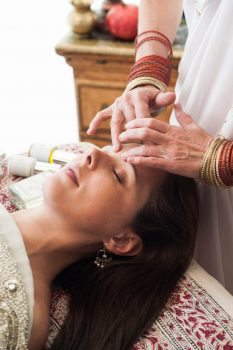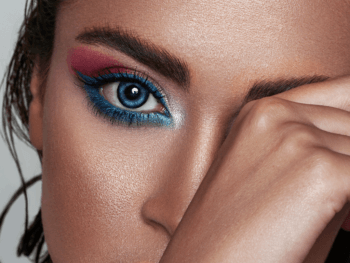
Meet ayurvedic beauty, the sister science of yoga.
A practice steeped in ancient Indian culture, ayurveda, the sister science of yoga and definitely the less popularized of the two, has gained a stronger cross cultural following in recent years, especially in regards to its beautification and rejuvenation practices. Hollywood starlets including Gwyneth Paltrow and Julia Roberts practice ayurvedic beauty and diet principles in their daily lives, while “trends” such as oil pulling, netti pots and head massages (although they may seem like recent discoveries) find their roots in this esteemed and trusted philosophy from the East. Although the connection seems less surprising, Bollywood A-listers including Ashwariya Bachan and Sonam Kapoor draw on the beauty of ayurveda as well in order to cultivate the balance of beauty and wellness in their lives (no wonder Ash’s hair is so healthy, right?!). The energy of ayurveda has spread so much over recent years serving as the inspiration behind many skin care products and spa treatments.

Photo Credit: www.sahajan.com
What is Ayurveda?
A science founded on establishing a balance between the body and the mind through natural sources, ayurveda has two tenants, medicine and beautification. Within ayurveda the key to finding a balance lies in the central concepts of the dosha, also known as our body type and our chakras, seven energy centres that run along our spine. In ayurveda, “there are three kinds of dosha types known as Vatta, Pitta and Kapha,” explains Andrea Olivera, owner and founder of Ayurvedic Touch Studio Spa Boutique in Toronto. Based on your dosha type you have a specific type of body and mind.
Finding a Balance Between the Body and Mind
The vatta is “prone to anxiety, defined by gentleness, the feeling of being overwhelmed and fear. Their bodies are characterized by dryness, construction and tightness,” she explains. As a result vattas age the fastest. In contrast, the pitta dosha is characterized by a firey and temperamental nature and prone to sensitivity and acne. Pittas are usually very thin and have very little oil in their skin. Finally, the kapha, is the slowest most lethargic of the three with a heavier set body and oilier skin. “Kaphas take the least care of themselves,” explains Olivera. Most people are a mixture of two dominating doshas and ayurvedic practices include both dietary, beauty and self-care practices to bring the body back to balance from the various extremes that characterize a dosha.
Finally, all of us have the seven chakras known as energy centres in our bodies that run from the base of the spine to the top of our heads. When one of these areas becomes blocked the energy in our body becomes stagnated resulting in both physical and emotional difficulties that prevent us from having the most enlightened and fulfilled life. Many ayurvedic beauty rituals and practices help to balance blockages in our chakras to help heal the body using aromatherapy, which you will see below. See the diagram below for more detail on what each chakra represents.

Photo Credit: astrogle.com
Experiencing Ayurvedic Rejuvenation
Olivera harnesses the power of these ayurvedic principles at her spa located on Bathurst Street in Toronto by offering her clients unique ayruvedic facials tailored to a client’s dosha. “The face is a mirror of everything that is happening in your body both physically in the organs and psycho-spiritual. So ayruvedic beauty rituals like the facial and Indian head massage (1.5 hours, $150 CDN) are an attempt to prevent what is happening in your body from manifesting on your face,” she explains.

Photo Credit: Ayurvedic Touch Studio Spa Boutique
For the facial Olivera chooses skin balancing ingredients and oils that coinside with one’s dosha. For myself, a vatta dosha, the focus went beyond the face with the oiling of the entire body including a back, abdomen, neck, shoulder and arms massage because “circulation needs to be brought back into the body,” says Olivera. Customized oils and ingredients used in my blissful facial and head massage experience included rose, pomegranate and hydrating jojoba in an effort to sedate and ground my mind. In contrast, a pitta treatment would use cooling rose water or coconut oil, while a kapha treatment would use a combination of the two. Olivera also guided me through an aromatic journey of seven different botanical blends that correspond with the body's seven chakras from her own product line. When choosing the scent I was asked to close my eyes and pick the one I was most drawn to because “Your nose knows what you need to go back to peace and will help you pick, ” says Olivera. The scent I chose was used in the massage.
With over 26 years practicing ayruvedic treatments on others through her work in the spa industry, which also included working as a trainer with Aveda and Ray Civello Spas, Olivera opened Ayruvedic Touch in 2000 and provides more traditional ayurvedic treatments. Other spas, including Aveda concept spas across the country, along with Ray Civello Salons and Pure and Simple in Toronto, use similar natural principles in the treatments on their spa menus. The options are endless if you wish to open up your body to this rich source of healing.
Bringing Ayurvedic Methods Home
Apart from spa treatments, modern skin care and aromatherapy products are also available at our fingertips. Sahajan, a new line in Canada founded by Lisa Mattam, is accessible ayurvedic beauty for the modern woman. Mattam recounts the moment of inspiration for Sahajan: “One day I came home and saw my little daughter covered in my face cream, and I thought it was so cute, but also remembered thinking 'you have to get that off your face, you have no idea what is in there!' And I said to her, 'these are things I use for you.' And they were a collection of natural oils and plant-based ingredients that my parents used on me as a child and that they also gifted to me when I had my daughter.” Although Mattam thought these were just family traditions, after doing a little digging she found these ingredients her and her family used were firmly based in ayurveda. After consulting with two ayurvedic doctors from Kerala in the South of India, two years later Sahajan skin care was born. The line includes the basics of a skin care and body regimen including a Nurture Hair Oil ($50), Ritual Body Oil ($55), Nourish Face Cream ($60), Protective Face Serum ($70) and Restorative Eye Cream ($45, all avaiable at sahajan.com) in a tri-dosha formulation to nourish the mind and the body.

Photo Credit: www.sahajan.com
Similarly, Intelligent Nutrients, founded by Horst Rechelbacher (the founder of Aveda) is a certified organic skin care and beauty brand that borrows from the practice of ayurveda with its seven aromatics that were formulated based on the body’s seven chakras. Rechelbacher’s had a huge interest in ayurveda “as he did a doctorate in the practice at Haridwaur University and also lived his life according to ayurvedic principles. When he started Aveda in the '70s he was ahead of his time,” explains Paula Veenema, the President PureStem Beauty Inc., the Canadian distributor of Intelligent Nutrients Canada. Rechelbacher was heavily involved in creating the formulations for all of the products, which is very unusual for a founder “but he grew up in Austria and his mother was a botanist so he had that connection,” says Veenema. The aromatics are meant to align with the natural lifestyle trend central to the brand while also working to ground one’s specific dosha based on each blend’s ingredients. This is seen in the names of each aromatic: Awaken, Seductive, Attune, Nurture, Inner Calm, Restore and Focus ($85 each, Murale and murale.ca). Similar to my experience at Ayurvedic Touch, you must smell the different aromatics and choose the one that your body is most drawn to, creating a unique experience for the consumer. “If you look at the science of smell and what it does to our bodies, we are 100 times more likely to remember smell than any other physical sensation. Smell is the most powerful source of your memory. In a perfect world you would have all seven of the blends at home and you would choose what is good for you in that day,” says Veenema.

Photo Credit: Intelligent Nutrients
A Return to the Basics
Overall, it's clear that the following of ayurveda has grown in recent years whether it's through spa treatments or pampering rituals one can use at home. For Mattam, there are a few reasons why: First, “We see that people have a real deep interest in understanding natural and organic ingredients and how to use them in their wellness practices and skin care is just one part of it.” Second, “there is such a commitment to yoga cross culturally, people are seeing the wisdom of the practice and if ayruveda is the sister practice then they are seeing it as the next place to go. Finally, there's a profound respect for the East as something people should look to. All of this is just a natural pathway,” she says.
Veeneme agrees. “This goes back to a yearning and a return to the basics of what we know works for our bodies. Ayruveda comes from this healthy and safe perspective that goes hand in hand with the sense of health and wellness that consumers are now looking for.”
Main Image Photo Credit: Ayurvedic Touch Studio Spa Boutique
Amanpreet Dhami
Author
Amanpreet Dhami is a Toronto based writer, editor and producer with a focus on beauty, fashion, wellness and lifestyle. Her work has appeared in TheKit.ca, 29secrets.com, Beautezine.com and Elevate Magazine, where she is the Editor-in-Chief. When she is not writing up a storm yuo can find her cooki...














































































































